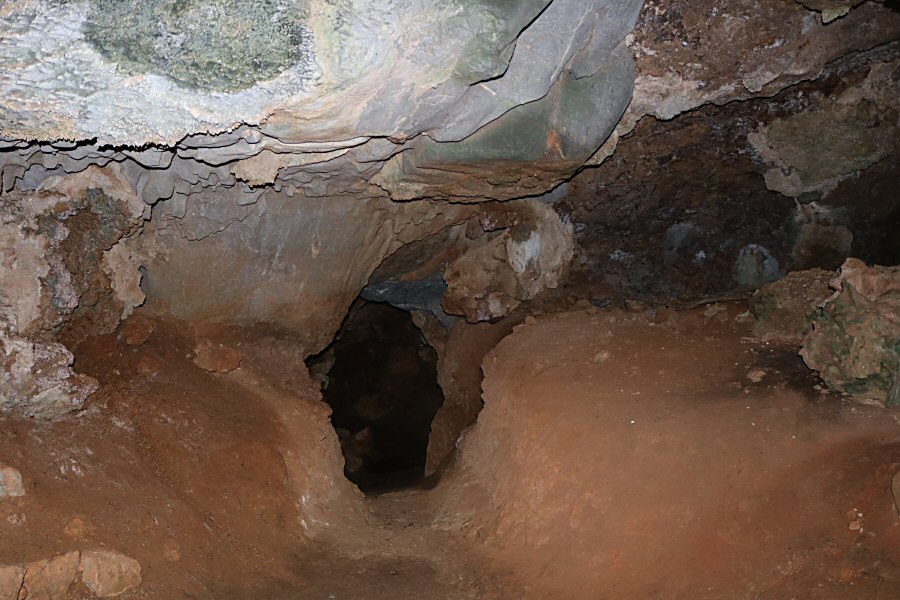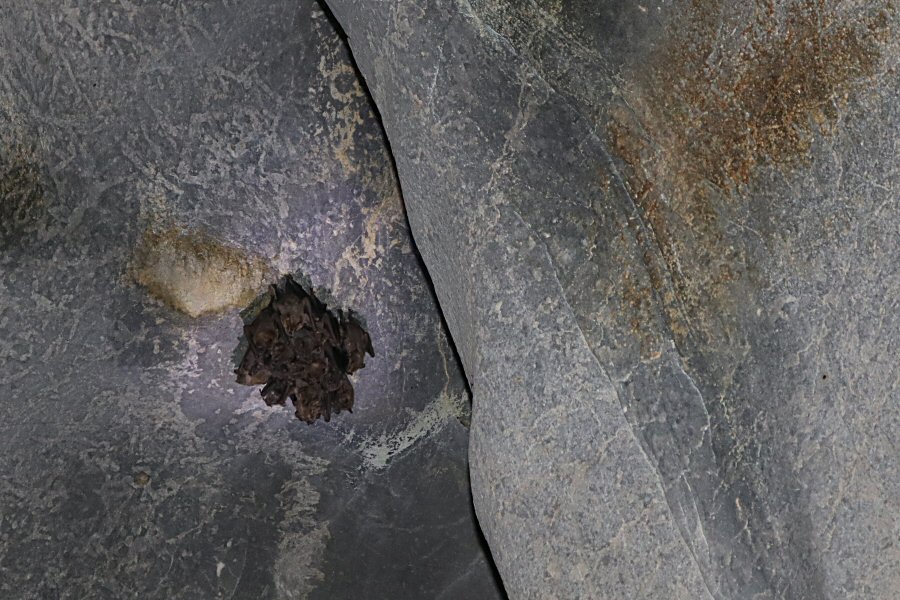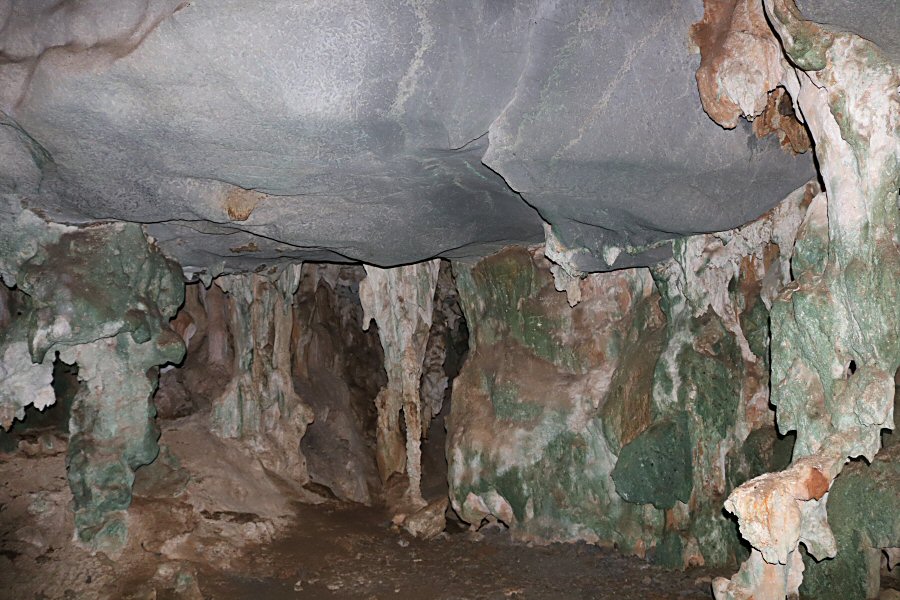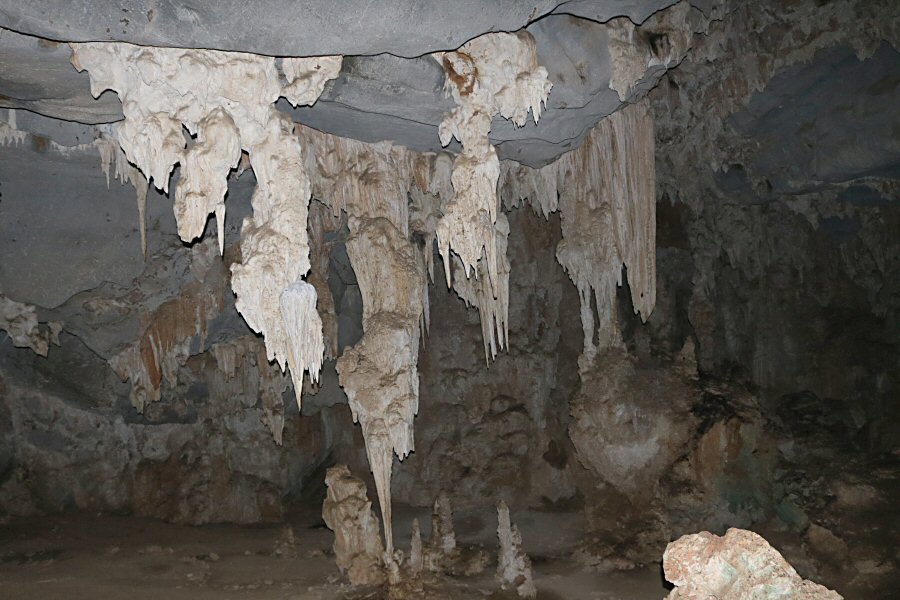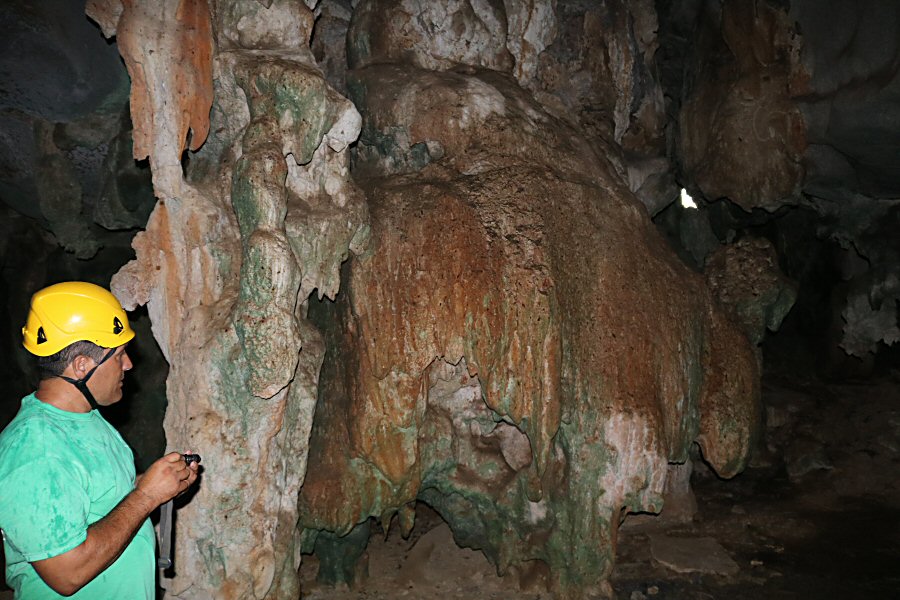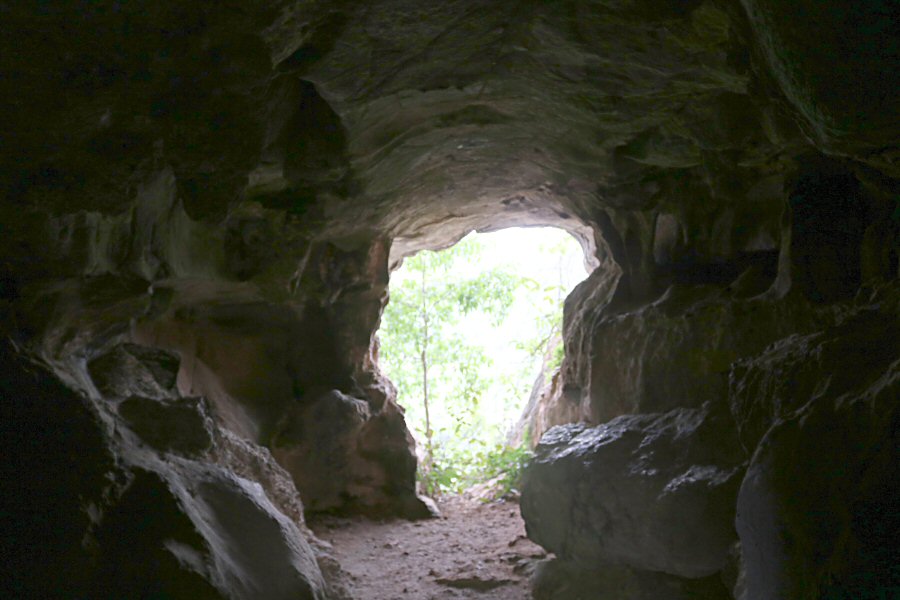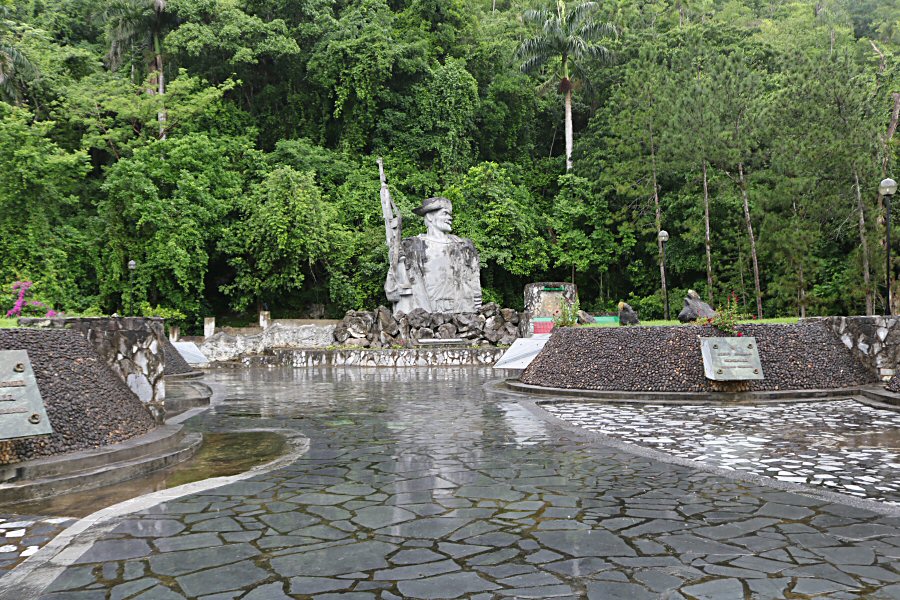
It is only possible to visit the cave with a local guide or on
an organized trip from Viñales.
It is possible to reach the cave mouth by climbing, which is located approximately 150 m above the ground. For this purpose, previously laid wooden sticks are used as handrail. Don’t forget to wear non-slip shoes and be aware that the cave requires some steep climbs and scrambling over slippery rocks. During this tour, which is approximately 1 km long and lasts approximately 90 minutes, the first three of the seven floors of karst caves can be explored. There is no artificial lighting system. A helmet and a head lamp required during the tour are provided by the guide.
Inside the cave it's not exactly cool, but at least cooler than outside. The floor is level and mostly dry, covered by the compressed cave clay created by the feet of the other visitors. The cave is made up of aquifers, many notable stalactite and stalagmite formations, rock pools, as well as different rocky features, which add a peculiar beauty to the place. By the way, it is also possible to come across some bats resting in the darkness of the cave. Among the interesting rock formations you will encounter a replica of an ancient indigenous mural. Some stalactites had good acoustic properties; it is possible to use them in playing percussion music. Although it is quite a difficult climb, the panoramic view of the valley, called Valle Quemado de Pineda, once you reach the the entrance of the cave, is worth it.
Nearby is the cave entrance which is named Cueva Icongnita, in which a 3,500 years old human skeleton was discovered which was identified as belonging to a preceramic aboriginal female, later dated to 3,420 + 200 years, using the collagen method, and the Cueva de Mesa with impressive indigenous petroglyphic murals, made by carving the rock. This shows that the caves were actually well known for a long time by the native people of the Valle de Quemado.
The caves were used as a hideout by the cimarrones, escaped slaves from the sugar plantations. The peasants in this area also knew the existence of this cavern system located in the Sierra de Quemado, at least the entrances and a few galleries. The waters of the pools should be an important source for planting when the Santo Tomás stream went through a period of drought. In the cave passages there was bat guano, which they could use in fertilizing the tobacco fields. When there were hurricanes outside, the caves were storm-proof shelters. And some cave passages were good access routes to the hoyos, fertile areas in the karst, practically inaccessible from the outside, surrounded on all sides by steep rock faces. So the farmers actually walked through the cave to work on their field. Quemado Valley inhabitants who visited the Santa Tomàs Cave called it the Cueva del Salón because it was the place where they held their celebrations, and it was easy access from the Valle de Quemado.
The cave was actually explored by a group of speleologists from the Sociedad Espeleológica de Cuba, headed by Dr. Antonio Núñez Jiménez, in 1954.
Those who fought against the bloody Batista regime hid in the numerous caves in this region in order to protect themselves from bombardment. Fidel Castro and Che Guevarra also stayed in the Gran Caverna de Santo Tomás for a while between 1957 and 1959 for this purpose. Dr. Antonio Núñez Jiménez, who knew these commanders well, played a major role in their choice, as did his knowledge and support of the caves in this region.
Later in 1984, the Escuela Nacional de Espelogia "Antonio Nunez Jimenez" was built right beneath the cave entrance. For a time, the school received a share of the cave entrance fee, but this was revoked after the death of Dr. Antonio Núñez Jiménez. The school later suffered an extensive damage from the flood, and his entire survey records were submerged in the flooding.
During the Missile Crisis in 1962 the cave was used by the military. Consequently, many of the speleothems near the entrance show signs of wear.
In 1989, the Gran Caverna de Santo Tomás was declared National Monument.
It has been arranged for tourism in 1994 and first cave was opened to the tourists.
You can also visit the little museum. Opening hours are: 10:00 to 22:00.
Before entering the cave path or after the cave tour, you can also visit the Los Malagones monument. The Malagones are the peasant militia organized by the Cuban government in the province of Pinar del Río in 1959 to confront banditry in that province. It was the first unit of its kind created in the country after the triumph of the Revolution and was the embryo of the future National Revolutionary Militias. This monument was erected in memory of Juan Quintín Paz Camacho, Juventino Torres Véliz and Jesús Padilla González, who were members of this group, which initially consisted of 12 people.
It is possible to reach the cave mouth by climbing, which is located approximately 150 m above the ground. For this purpose, previously laid wooden sticks are used as handrail. Don’t forget to wear non-slip shoes and be aware that the cave requires some steep climbs and scrambling over slippery rocks. During this tour, which is approximately 1 km long and lasts approximately 90 minutes, the first three of the seven floors of karst caves can be explored. There is no artificial lighting system. A helmet and a head lamp required during the tour are provided by the guide.
Inside the cave it's not exactly cool, but at least cooler than outside. The floor is level and mostly dry, covered by the compressed cave clay created by the feet of the other visitors. The cave is made up of aquifers, many notable stalactite and stalagmite formations, rock pools, as well as different rocky features, which add a peculiar beauty to the place. By the way, it is also possible to come across some bats resting in the darkness of the cave. Among the interesting rock formations you will encounter a replica of an ancient indigenous mural. Some stalactites had good acoustic properties; it is possible to use them in playing percussion music. Although it is quite a difficult climb, the panoramic view of the valley, called Valle Quemado de Pineda, once you reach the the entrance of the cave, is worth it.
Nearby is the cave entrance which is named Cueva Icongnita, in which a 3,500 years old human skeleton was discovered which was identified as belonging to a preceramic aboriginal female, later dated to 3,420 + 200 years, using the collagen method, and the Cueva de Mesa with impressive indigenous petroglyphic murals, made by carving the rock. This shows that the caves were actually well known for a long time by the native people of the Valle de Quemado.
The caves were used as a hideout by the cimarrones, escaped slaves from the sugar plantations. The peasants in this area also knew the existence of this cavern system located in the Sierra de Quemado, at least the entrances and a few galleries. The waters of the pools should be an important source for planting when the Santo Tomás stream went through a period of drought. In the cave passages there was bat guano, which they could use in fertilizing the tobacco fields. When there were hurricanes outside, the caves were storm-proof shelters. And some cave passages were good access routes to the hoyos, fertile areas in the karst, practically inaccessible from the outside, surrounded on all sides by steep rock faces. So the farmers actually walked through the cave to work on their field. Quemado Valley inhabitants who visited the Santa Tomàs Cave called it the Cueva del Salón because it was the place where they held their celebrations, and it was easy access from the Valle de Quemado.
The cave was actually explored by a group of speleologists from the Sociedad Espeleológica de Cuba, headed by Dr. Antonio Núñez Jiménez, in 1954.
Those who fought against the bloody Batista regime hid in the numerous caves in this region in order to protect themselves from bombardment. Fidel Castro and Che Guevarra also stayed in the Gran Caverna de Santo Tomás for a while between 1957 and 1959 for this purpose. Dr. Antonio Núñez Jiménez, who knew these commanders well, played a major role in their choice, as did his knowledge and support of the caves in this region.
Later in 1984, the Escuela Nacional de Espelogia "Antonio Nunez Jimenez" was built right beneath the cave entrance. For a time, the school received a share of the cave entrance fee, but this was revoked after the death of Dr. Antonio Núñez Jiménez. The school later suffered an extensive damage from the flood, and his entire survey records were submerged in the flooding.
During the Missile Crisis in 1962 the cave was used by the military. Consequently, many of the speleothems near the entrance show signs of wear.
In 1989, the Gran Caverna de Santo Tomás was declared National Monument.
It has been arranged for tourism in 1994 and first cave was opened to the tourists.
You can also visit the little museum. Opening hours are: 10:00 to 22:00.
Before entering the cave path or after the cave tour, you can also visit the Los Malagones monument. The Malagones are the peasant militia organized by the Cuban government in the province of Pinar del Río in 1959 to confront banditry in that province. It was the first unit of its kind created in the country after the triumph of the Revolution and was the embryo of the future National Revolutionary Militias. This monument was erected in memory of Juan Quintín Paz Camacho, Juventino Torres Véliz and Jesús Padilla González, who were members of this group, which initially consisted of 12 people.

Fidel Castro Ruz with Celia Sánchez and other commanders in the
Cueva de Mesa of the Gran Caverna de Santo Tomas.
